
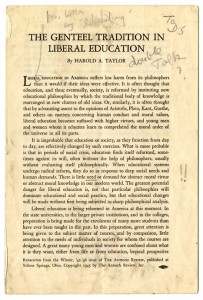
Ezra Pound, handwritten notes on “The Genteel Tradition in Liberal Education” by Harold A. Taylor, undated (Literary Manuscripts and Correspondence)
The University of Houston Special Collections is excited to announce the publication of the Literary Manuscripts and Correspondence finding aid. Items in this collection, which include letters, notes, and writings by several major literary figures, were previously housed separately in our A-Z files, but have now been gathered into one place to provide easier access for researchers interested in contemporary literature.
In this collection you’ll find items from many recognizable writers, such as Henry James, Gertrude Stein, Ezra Pound, Charles Bukowski, and Eugene O’Neill. The materials also cover a wide range of time periods and locales. The oldest item, a letter from English poet Richard Braithewate, was written in 1634, while the newest, an article written by James Thurber for the magazine Adirondack Life, is from 1991. The collection also contains materials both from close to home, including letters written by Texas’ own Katherine Anne Porter, and abroad, such as letters written by Irish novelist Norah Hoult and an autograph from Romanian playwright Eugène Ionesco.
Take a closer look at the finding aid to see which of your favorite authors make an appearance, or better yet, come visit us at Special Collections and see these unique and interesting materials in person!
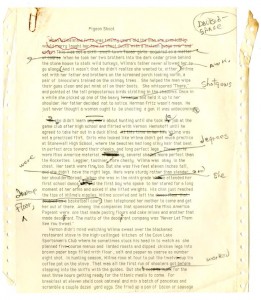
Page one of “Pigeon Shoot” chapter draft from Truck Dance, featuring edits from Donald Barthelme (Olive Hershey Papers).
We are very pleased to announce the recent publication of the Olive Hershey Papers finding aid.
Born in Houston, Texas in 1941, Olive Hershey was educated at Connecticut College and the University of Texas at Austin before attending the University of Houston’s Creative Writing Program. Studying under trailblazing postmodernist Donald Barthelme and alongside the likes of Tracy Daugherty, Hershey earned her M.A. from UH in 1987. Her published works include a collection of poems entitled Floating Face Up and her novel Truck Dance (originally her thesis while studying at UH).
The Olive Hershey Papers contain drafts, revisions, editorial notes, and writings from a handful of Hershey’s projects, however the bulk of materials are related to Truck Dance. Particularly noteworthy are the drafts of the various chapters filled with the edits and suggested revisions of Daugherty and the unmistakable scrawl and insight of Barthelme.
A fine complement to our Contemporary Literature collections, the Olive Hershey Papers help provide even more context for a community of authors that established the University of Houston as a destination for emerging and talented literary voices. For more information on the life and work of Olive Hershey we invite you to consult this newly published finding aid. The original materials of the Olive Hershey Papers can be viewed in the Special Collections Reading Room.
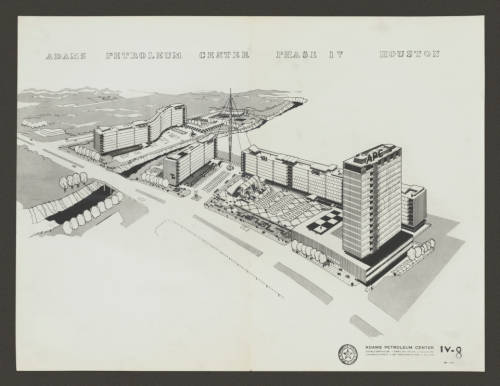
Donald Barthelme, Adams Petroleum Center (c. 1955), aerial view of the proposed complex on Fannin at Brays Bayou. (Donald Barthelme Architectural Papers and Photographs)
The UH Digital Library recently announced its newest addition—the Donald Barthelme Sr. Architectural Papers and Photographs. The Digital Library makes accessible online important holdings of the University of Houston libraries and archives. These new items illustrate the work of noted architect Donald Barthelme through pencil sketches, photographs, and the detailed working drawings used to construct his buildings. They are only a small part of the total found in the Donald Barthelme Sr. Architectural Papers, but they illustrate his most important projects.
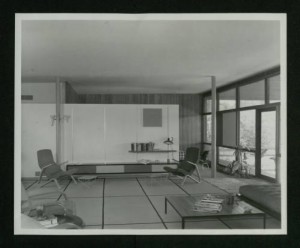
Barthelme Residence (c. 1952), living room looking east with parents’ bedroom in the background. (Donald Barthelme Sr. Architectural Papers and Photographs)
The earliest is Barthelme’s own residence (1939), a small flat-roof modernist house on Wynden Drive. The open plan created the illusion of a larger space within. A grid of Japanese tatami mats covering the floor met a similar grid of windows facing the patio. He filled the living room with iconic modernist furniture by Alvar Aalto, Charles Eames, and Eero Saarinen. In an unusual feature, the parents’ bedroom was open to the living room; a folding screen provided privacy from the children.
St. Rose of Lima Church and School won an award of merit from the American Institute of Architects in 1948 for its simple and austere brick forms. But Barthelme’s most important building was the award-winning West Columbia Elementary School,
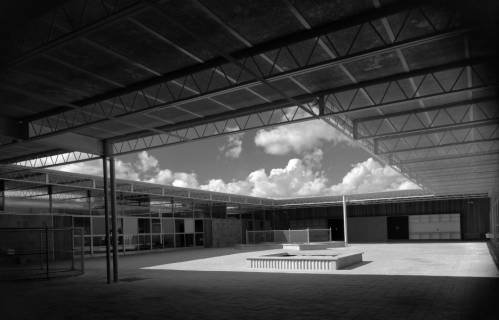
Donald Barthelme, West Columbia Elementary School (1951), north court. (Donald Barthelme Architectural Papers and Photographs)
completed in 1951. Its innovative design departed from the traditional practice of placing classrooms along both sides of a long corridor. Instead, he arranged the building around two large courtyards; classrooms opened to the courts through floor-to-ceiling glass walls. The picture of a teacher and her students captures the cheerful atmosphere of Barthelme’s light-filled classrooms.
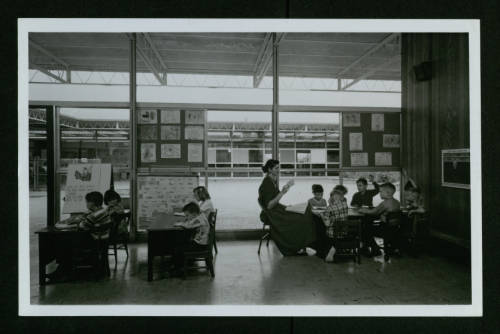
West Columbia Elementary School (1951), view of classroom with teacher and students. (Donald Barthelme Architectural Papers and Photographs)
In the mid-1950s, the Adams Petroleum Company hired Barthelme to design its new office building on Fannin Street. The company hoped to develop the large site as an office park, with the APC building to be followed by other office buildings. Barthelme spent hundreds of hours planning the large complex before Adams abandoned the scheme. The Digital Library contains a selection of rarely seen studies for this ambitious unbuilt project.
Through the UH Digital Library the public now has easy access to these images, some of which have never been published. As usual, the Donald Barthelme Sr. Architectural Papers are available to researchers at the UH Libraries’ Special Collections department.